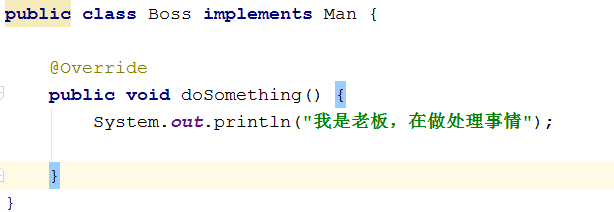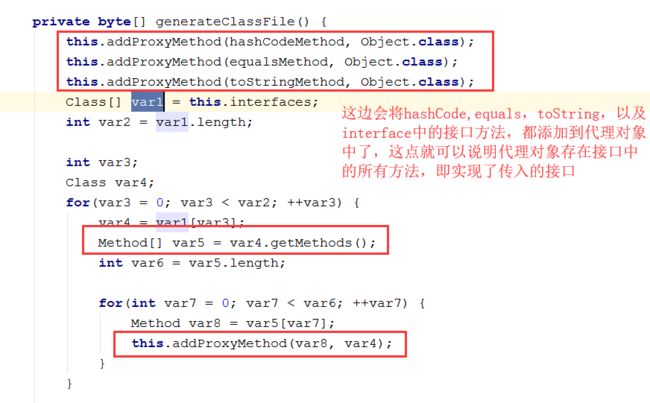通过这篇文章你会知道如下:
-
动态代理如何实现?
-
代理对象与真实对象之间是什么关系?
-
通过代理对象的调用,invocationHandler中的invoke方法是如何被调用的
目前尚未厘清字节码是如何生成,代理对象中的方法体是如何写入的?
动态代理就是将代理插入到客户和目标之间,从而为客户和目标对象之间引入一定的间接性,这个间接性就可以给代理提供很多的活动空间,代理可以在调用目标对象的前后做些通知操作,从而实现新的功能或者扩展目标对象的功能;
-
动态代理常规写法例子:
-
调用过程分析
从上面的例子得知,proxy是通过Proxy.newProxyInstance产生的,此时就有如下疑问:
- 调用proxy.doSomething时候,内部是如何调用到invoke方法?
- 参数interface作用是啥?
下面就开始分析这些疑问
下面这张图说明,代理对象是通过getProxyClass0方法产生的,最后通过newIntstance实例化,同时传入invokehandler对象
下图说明代理对象的产生最终会落到proxyClassFactory中,注释也有说明这点,但是具体为什么会落到proxyClassFactory,你打个断点跟踪会,自然而然就知道了。所以现在的重点就在proxyClassFactory里面是如何产生对象的?
private static final class ProxyClassFactory
implements BiFunction[], Class>
{
// prefix for all proxy class names
private static final String proxyClassNamePrefix = "$Proxy";
// next number to use for generation of unique proxy class names
private static final AtomicLong nextUniqueNumber = new AtomicLong();
@Override
public Class apply(ClassLoader loader, Class[] interfaces) {
Map, Boolean> interfaceSet = new IdentityHashMap<>(interfaces.length);
for (Class intf : interfaces) {
/*
* Verify that the class loader resolves the name of this
* interface to the same Class object.
*/
Class interfaceClass = null;
try {
interfaceClass = Class.forName(intf.getName(), false, loader);
} catch (ClassNotFoundException e) {
}
if (interfaceClass != intf) {
throw new IllegalArgumentException(
intf + " is not visible from class loader");
}
/*
* Verify that the Class object actually represents an
* interface.
*/
if (!interfaceClass.isInterface()) {
throw new IllegalArgumentException(
interfaceClass.getName() + " is not an interface");
}
/*
* Verify that this interface is not a duplicate.
*/
if (interfaceSet.put(interfaceClass, Boolean.TRUE) != null) {
throw new IllegalArgumentException(
"repeated interface: " + interfaceClass.getName());
}
}
String proxyPkg = null; // package to define proxy class in
int accessFlags = Modifier.PUBLIC | Modifier.FINAL;
/*
* Record the package of a non-public proxy interface so that the
* proxy class will be defined in the same package. Verify that
* all non-public proxy interfaces are in the same package.
*/
for (Class intf : interfaces) {
int flags = intf.getModifiers();
if (!Modifier.isPublic(flags)) {
accessFlags = Modifier.FINAL;
String name = intf.getName();
int n = name.lastIndexOf('.');
String pkg = ((n == -1) ? "" : name.substring(0, n + 1));
if (proxyPkg == null) {
proxyPkg = pkg;
} else if (!pkg.equals(proxyPkg)) {
throw new IllegalArgumentException(
"non-public interfaces from different packages");
}
}
}
if (proxyPkg == null) {
// if no non-public proxy interfaces, use com.sun.proxy package
proxyPkg = ReflectUtil.PROXY_PACKAGE + ".";
}
/*
* Choose a name for the proxy class to generate.
*/
long num = nextUniqueNumber.getAndIncrement();
String proxyName = proxyPkg + proxyClassNamePrefix + num;
/*
* Generate the specified proxy class.
*/
byte[] proxyClassFile = ProxyGenerator.generateProxyClass(
proxyName, interfaces, accessFlags);
try {
return defineClass0(loader, proxyName,
proxyClassFile, 0, proxyClassFile.length);
} catch (ClassFormatError e) {
/*
* A ClassFormatError here means that (barring bugs in the
* proxy class generation code) there was some other
* invalid aspect of the arguments supplied to the proxy
* class creation (such as virtual machine limitations
* exceeded).
*/
throw new IllegalArgumentException(e.toString());
}
}
}
proxyClassFactory类中可以看到代理对象产生的名字构成过程,同时会处理如果实现的接口访问权限不是public的情况;
String proxyName = proxyPkg + proxyClassNamePrefix + num;
生成代理对象的过程在这段代码里面,真正产生队里对象的类是ProxyGenerator.generateClassFile方法
最终生成的代理对象如下,可以发现在doSomething方法中,发现是调用了h.invokerhandler的invoke方法,这个h对象则是父类Proxy中的属性,通过构造方法进行对象赋值;所以就可以解释最初的疑问了。
另外要获取这个对象的反编译的源码,需要改变sun.misc.ProxyGenerator.saveGeneratedFiles参数,才能写入到硬盘,具体为什么是true,在ProxyGenerator.generateProxyClass方法中可以看到原因。
System.getProperties().put("sun.misc.ProxyGenerator.saveGeneratedFiles", "true");
package com.sun.proxy;
import com.example.proxy.Man;
import java.lang.reflect.InvocationHandler;
import java.lang.reflect.Method;
import java.lang.reflect.Proxy;
import java.lang.reflect.UndeclaredThrowableException;
public final class $Proxy0
extends Proxy
implements Man {
private static Method m1;
private static Method m3;
private static Method m2;
private static Method m0;
public $Proxy0(InvocationHandler paramInvocationHandler)
throws {
super(paramInvocationHandler);
}
public final boolean equals(Object paramObject)
throws {
try {
return ((Boolean) this.h.invoke(this, m1, new Object[]{paramObject})).booleanValue();
} catch (Error | RuntimeException localError) {
throw localError;
} catch (Throwable localThrowable) {
throw new UndeclaredThrowableException(localThrowable);
}
}
public final void doSomething()
throws {
try {
this.h.invoke(this, m3, null);
return;
} catch (Error | RuntimeException localError) {
throw localError;
} catch (Throwable localThrowable) {
throw new UndeclaredThrowableException(localThrowable);
}
}
public final String toString()
throws {
try {
return (String) this.h.invoke(this, m2, null);
} catch (Error | RuntimeException localError) {
throw localError;
} catch (Throwable localThrowable) {
throw new UndeclaredThrowableException(localThrowable);
}
}
public final int hashCode()
throws {
try {
return ((Integer) this.h.invoke(this, m0, null)).intValue();
} catch (Error | RuntimeException localError) {
throw localError;
} catch (Throwable localThrowable) {
throw new UndeclaredThrowableException(localThrowable);
}
}
static {
try {
m1 = Class.forName("java.lang.Object").getMethod("equals", new Class[]{Class.forName("java.lang.Object")});
m3 = Class.forName("com.example.proxy.Man").getMethod("doSomething", new Class[0]);
m2 = Class.forName("java.lang.Object").getMethod("toString", new Class[0]);
m0 = Class.forName("java.lang.Object").getMethod("hashCode", new Class[0]);
return;
} catch (NoSuchMethodException localNoSuchMethodException) {
throw new NoSuchMethodError(localNoSuchMethodException.getMessage());
} catch (ClassNotFoundException localClassNotFoundException) {
throw new NoClassDefFoundError(localClassNotFoundException.getMessage());
}
}
}








